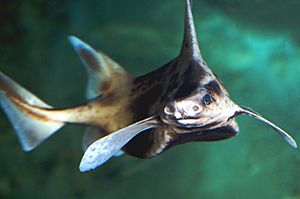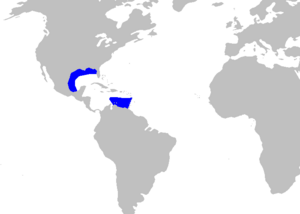Caribbean roughshark facts for kids
Quick facts for kids Caribbean roughshark |
|
|---|---|
 |
|
| Conservation status | |
| Scientific classification | |
| Genus: |
Oxynotus
|
| Species: |
caribbaeus
|
 |
|
| Range of the Caribbean roughshark (in blue) | |
The Caribbean roughshark (Oxynotus caribbaeus) is a unique type of rough shark. It belongs to the family called Oxynotidae. You can find this shark deep in the Caribbean Sea. It lives on the upper parts of the continental slope, which is like the edge of the continent underwater. These sharks live very deep, usually between 400 and 450 meters (about 1,300 to 1,475 feet) below the surface. They can grow to be about 50 centimeters (20 inches) long.
Scientists believe the Caribbean roughshark moves slowly. It probably hunts small creatures that live on the seafloor. We don't know a lot about how these sharks live their whole lives. However, researchers are now watching them more closely in their natural home. Sometimes, these sharks are accidentally caught by fishing boats that drag nets along the bottom. This is called bycatch.
Contents
Discovering the Caribbean Roughshark
Who Named This Shark?
A scientist from Venezuela, Dr. Fernando Cervigón, was the first to describe this shark. He gave it the scientific name Oxynotus caribbaeus.
What Does the Caribbean Roughshark Look Like?
A Chubby Shark with Special Fins
The Caribbean roughshark is a small shark. It lives deep in the ocean off the coast of Venezuela. It's easy to tell apart from other sharks in the Oxynotus group. Adult male sharks can grow up to 50 centimeters (about 20 inches) long. Female sharks are thought to grow even longer, but scientists haven't studied many of them yet.
This shark has a short, blunt snout and head. It looks quite chubby, not like the typical sleek shark you might imagine! It has two dorsal fins (the fins on its back). These fins help tell it apart from other Oxynotus sharks.
Unique Fins and Skin
The first dorsal fin points forward. It is very long, thick, and shaped like a triangle. The second dorsal fin is similar but not as long. Like some other Oxynotus sharks, the Caribbean roughshark does not have an anal fin (a fin on its underside near the tail).
Its skin is covered in rough dermal denticles. These are like tiny teeth on its skin. For a shark of its size, these denticles are unusually large. It also has small, round holes called spiracles behind its eyes, on top of its head. These help it breathe.
Colors and Teeth
The Caribbean roughshark has distinct colors. Its head, body, and tail are light grayish. They have dark bands and blotches. However, its pectoral fins (side fins) and pelvic fins (bottom fins near the belly) are noticeably lighter in color.
Its teeth are also special. The upper teeth are spear-shaped, with about 12 rows. The lower teeth are blade-like, also with about 12 rows.
Where Does the Caribbean Roughshark Live?
Deep Waters of the Atlantic
You can find Oxynotus caribbaeus in the western Atlantic Ocean. This includes the bottom of the Gulf of Mexico and the Caribbean Sea. People have seen this shark in the waters near the Bahamas, Honduras, and Venezuela.
It lives in water that is usually between 400 and 450 meters (about 1,300 to 1,475 feet) deep. At these depths, the water temperature is around 10 °C (50 °F). This means it lives on the seafloor, making it a demersal fish.
What Does the Caribbean Roughshark Eat?
Bottom-Dwelling Meals
We don't know much about what this shark eats. But because of its unusual teeth, scientists think it feeds on creatures that live near the bottom of the ocean. Its spear-shaped upper teeth and blade-like lower teeth are perfect for catching invertebrates (animals without backbones) and small fish found on the seafloor.
How Do Caribbean Roughsharks Have Babies?
Eggs Inside the Mother
This type of shark is an ovoviviparous species. This means the baby sharks grow inside eggs, but the eggs stay inside the mother's body. The eggs hatch inside her, and then the live young are born. Baby Caribbean roughsharks, both male and female, are thought to be about 20 to 21 centimeters (8 to 8.3 inches) long when they are born.
Protecting the Caribbean Roughshark
Threats from Fishing
The Caribbean roughshark lives in deep waters where special fishing boats operate. These deepwater fisheries can harm populations of sharks that are already rare and not well understood. Even though this shark is not often caught by accident (as bycatch), any accidental catch can hurt its small population.
No Commercial Use
This shark has very little commercial value. If it is caught, it might be used for fishmeal (food for other animals) or bait. Sometimes, it can be processed for oil or even eaten by humans after being smoked and salted.
Images for kids
See also
 In Spanish: Cerdo marino antillano para niños
In Spanish: Cerdo marino antillano para niños
- Froese, Rainer, and Daniel Pauly, eds. (2006). "Oxynotus caribbaeus" in FishBase. July 2006 version.




